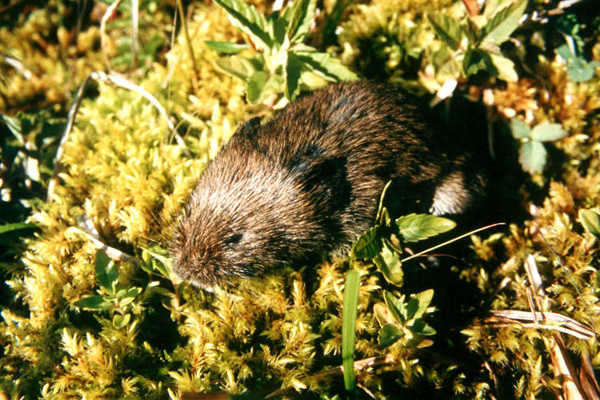Many may not know the northern bog lemming lives in Southeast Alaska —but the U.S. Fish and Wildlife Service is considering the rarely seen mammal’s status as endangered across the United States and is asking for relevant information from the public by Nov. 17.
Local naturalist Bob Armstrong, who spends almost every day out observing Southeast’s wildlife, said to his knowledge, he’s never seen a northern bog lemming.
“The only lemming I’ve seen and photographed is the collared lemming, and that was when I was living in Fairbanks,” he said. “I was surprised about how many records occur in Southeast.”
Research scientist Dean Pearson, who took what he believes to be the only photo of the animal as an undergraduate two decades ago, said the animals are “a little bit mysterious.”
“We don’t know a lot about them,” he said. “They’re just really sporadic; they’re not abundant anywhere.”
The northern bog lemming’s journey within the USFWS is just beginning, Candidate & Classification Coordinator Krishna Gifford, who works for the Northeast Region of the USFWS, wrote in an email. Ninety-day findings are based entirely on the information in the petition that asked for listing, Gifford wrote. In the case of the Northern Bog Lemming, Wild Earth Guardians filed the petition in 2014.
In a release, Taylor Jones, the endangered species advocate who co-wrote the petition, said the group is “delighted that the regal fritillary (a kind of butterfly) and bog lemming are one step closer to Endangered Species Act protections,” adding “The rarity of both these species is an important red flag for the health of their ecosystems, and we hope the Service will move quickly to protect them.”
Now, the USFWS is “actively seek(ing) out information from all public and private sources,” Gifford wrote in an email. “We can accept substantive information right up until we make a final decision, so while it is ideal for us to get new information during the open public information solicitation period, we can accept information after the Nov. 17 date in the Federal Register.”
Over the course of the next year or so, the USFWS will do a more in-depth study on the species.
According to a report from scholars within the Alaska Natural Heritage Program out of the University of Alaska, Anchorage, no one knows the species’ population size in the state, but the animal is uncommon. Northern bog lemmings range between south of the Brooks Range throughout interior Alaska, and on mainland Southeast, making their homes in burrows up to a foot deep in cold bogs or places with springs; they live mostly in the boreal forests, but also, sometimes, near rocky cliffs.
In the continguous U.S., the species is considered a glacial relict species, Pearson said, meaning scientists believe it survived from when glaciers last receded in the late Pleistocene, 10,000 to 11,000 years ago.
“Given its abundance and broken distribution in Alaska, it is likely a relict there as well, but this is hypothetical,” he wrote in an email.
Gifford doesn’t yet have an exact date for when the agency will decide whether or not the bog lemming warrants listing. Another possibility, as with all potential ESA listings, may be that the species warrants listing as endangered but isn’t added to the list because there are “higher priority listing actions,” in which case the agency reassesses that decision annually.
If they decided it merited listing as threatened or endangered, they would get peer and public review and comment on the proposed rule, she wrote. They may also designate critical habitat.
Armstrong and retired ecologist Mary Willson wrote about lemmings in “Natural Connections in Alaska,” a 2014 book.
Alaska’s home to three lemming species, they wrote – brown, bog, which they describe as “little-studied,” and collared. Populations tend to increase quickly every three or four years, then crash. (Also, the popular idea that lemmings dive off cliffs en masse isn’t true. Lemmings don’t commit mass suicide.) Around Alaska, they’re important food for pomarine jaegers, snowy owls and arctic foxes.
Read the petition here: http://www.wildearthguardians.org/site/DocServer/WildEarthGuardiansPetitionNorthernBogLemming.pdf?docID=14742
Read more on USFWS’s website here: http://www.fws.gov/midwest/es/soc/Batch90DaySept2015.html.
• Contact Juneau Empire outdoors writer Mary Catharine Martin at maryc.martin@capweek.com.

